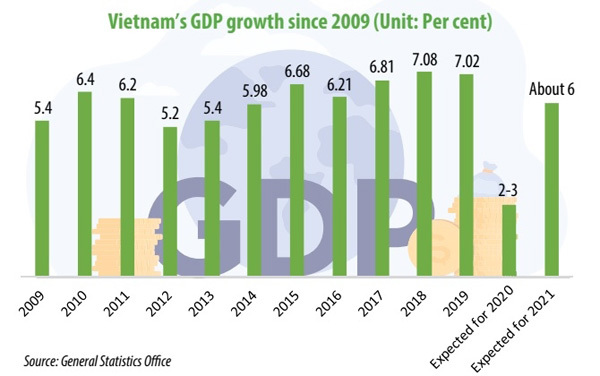 |
The government has sent a report to the National Assembly’s (NA) Standing Committee, under which the Vietnamese economy in 2021 is expected to see reassessment in terms of scale, with total GDP of about VND9 quadrillion ($391.3 billion), in the event that the economy will grow about 6 per cent as set by the NA two weeks ago.
If this figure is achieved, Vietnam’s GDP will be higher than that of Singapore ($363.39 billion), Malaysia ($357.27), and the Philippines ($334.04 billion) in 2019, according to calculations by the World Bank and the International Monetary Fund (IMF).
Such a big scale for Vietnam will come from the reassessment of GDP in 2021 under the support of the IMF, in an attempt to make more accurate decisions and policies in macroeconomic monitoring.
Over past years, though Vietnam’s statistical inputs have been improving, data gathered remains insufficient for accurately calculating annual GDP targets. Furthermore, the development of the private sector has not been reflected fully in its data. For example, the performance of 76,000 enterprises, including several giants, has yet to be included in the calculation of the existing GDP size.
In mid-October the IMF released a forecast on economic outlook of the global economy in 2020, under which it projected that this year the Vietnamese economy will rank fourth in Southeast Asia, with a scale of $340.6 billion, bigger than that of Singapore ($337.5 billion) and Malaysia ($336.3 billion), and lower than that of Thailand ($509.2 billion), the Philippines ($367.4 billion), and Indonesia ($1 trillion). The IMF also forecast that per capita GDP this year will rank sixth in Southeast Asia, at $3,497.
Latest government figures show that in 2020 under existing calculations, if the economy grows 2-3 per cent as expected, its GDP is estimated to be about VND6.3 quadrillion ($273.9 billion), up by VND263 trillion ($11.43 billion) against 2019, lower than the on-year increase of nearly VND500 trillion ($21.74 billion) last year.
A necessity
According to the General Statistics Office (GSO), now is the time for Vietnam to reassess GDP scale as it is an important macroeconomic index.
“The reassessment of the GDP size is aimed to more accurately reflect the scale and capacity of the economy, enhancing the country’s economic status regionally and internationally,” said a recent GSO statement.
In the context that Vietnam is designing its Socioeconomic Development Strategy for 2021-2030 and Development Plan for 2021-2025, the reassessment will help the country make correct orientations for development over the next decade, said the statement.
Minister of Planning and Investment Nguyen Chi Dung said, “It is a necessary and normal job in order to exactly and comprehensively identify the economy’s scale in line with international practice. Many nations have done this job several times, with their economies seeing a 3-4 per cent rise in GDP a year.”
Since 2010, many nations including the US, Canada, Germany, Russia, and Italy have reviewed and revised their GDP scale and other relevant macro indexes.
According to minister Dung, the process of GDP reassessment has been conducted in a strict and scientific process with transparency. The process has been consulted by experts and scientists from the IMF and the United Nations.
“More importantly, the reassessment does not lead to change in the GDP calculation method, but has been supplemented with new information and updated statistical regulations of the UN and with reassessed information sources based on surveys over economic sectors that have yet to be included in existing calculations,” the minister said.
Based on such reassessment, Vietnam’s GDP scale increased by an average 25.4 per cent annually in 2010-2017. In 2021, the GDP growth is expected to be about 6 per cent and per capital GDP is forecast to be $3,700.
According to the GSO, the reassessment will have significant impacts on the economy. Specifically, it will create a remarkable increase in the GDP value and per capita GDP, which will help lead to changes in socioeconomic development orientations and consumption models of the public. This also means that Vietnam may sooner reach its wanted status of a high middle-income country.
Improvements
An IMF team led by Era Dabla-Norris, a division chief of the Asian I Division in the IMF’s Asia Pacific Department and mission chief for Vietnam, carried out a virtual mission over October and November to conduct discussions with Vietnam’s authorised agencies as well as representatives from the private sector, think tanks, academia, and financial institutions.
Norris said that the fiscal response to COVID-19 here has been largely geared towards supporting vulnerable households and firms and has benefited from prudent policies adopted in the past. Monetary policy easing and temporary financial relief measures by the State Bank of Vietnam have alleviated liquidity pressures, lowered the cost of funding, and facilitated continued flow of credit.
“A strong recovery is expected in 2021. Growth is projected to strengthen to 6.5 per cent as normalisation of domestic and foreign economic activity continues. Fiscal and monetary policies are expected to be supportive, although to a lesser extent than in 2020. Inflation is expected to remain close to the authorities’ target at 4 per cent,” Norris said.
Spanish data firm FocusEconomics told VIR last week that its updated forecast showed that Vietnam’s economy may grow 2.7 per cent this year before soaring to 7.3 per cent next year, and 6.8 per cent in 2022 – rates that are the highest in Asia. VIR
Dat Nguyen

New report finds GDP growth revised up 25.4 per cent in 2010-2017
A new report on Vietnam's macroeconomics and GDP revision has been released by Prof Can Van Luc and researchers from the BIDV Training and Research Institute

The State does not favor any economic sector
Assoc. Prof Dr. Vu Van Phuc proposed adding to the draft Political Reports submitted to the 12th Party Congress a section on economic sectors in the transitional economy to socialism in Vietnam.